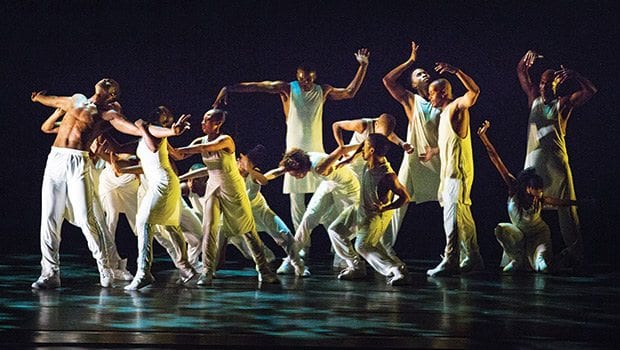Alvin Ailey performs at Wang Theatre
Dance troupe offers new and traditional works

Alvin Ailey American Dance Theater came to Boston last week, performing an array of traditional and new works in five shows at Citi Performing Arts Center Wang Theatre.
Presented by the Celebrity Series of Boston, the company has visited Boston almost annually since 1968. These visits include sessions with the city’s young dancers. Lawrence native Belen Pereyra, now in her fifth season with the company, joined colleagues to lead master classes at her alma mater, Boston Arts Academy, and at several other local schools.
Saturday night, the company performed three Boston premieres, each a showcase of its power to turn historic human events into exalting works of dance.
“Exodus” (2015), by acclaimed hip-hop choreographer Rennie Harris, adds a new chapter to Alvin Ailey’s 1960 masterpiece, “Revelations,” a celebration of African American faith and tenacity. Harris evokes suffering and spiritual transcendence in the lingo of a next-generation vein of dance, hip-hop.
Sampling music by various artists, with costumes by Jon Taylor and lighting by James Clotfelter, “Exodus” renders a journey toward liberation. Its 16 dancers begin in the urgent, angular language of street dance. Set to gospel and house music along with spoken word, the work blends the bravura twists and turns of b-boying, popping and locking with pelvis-powered, sinuous West African movements.
Rising from the floor like fuzzy-haired zombies and outfitted in street garb — caps, baggy pants and sneakers — the dancers take action, arms and legs extending, hands clapping, and bodies propelled by rapid, intricate footwork. Jeroboam Bozeman enters this assembly as an electrifying presence. Tall, bare-chested and wearing flowing white pants, he makes long, commanding moves across the floor. Soon the entire corps is transformed, attired in white tunics, elevated and unified in spirit.
Reckoning with suffering of another era is “No Longer Silent” (2007), choreographed by company artistic director Robert Battle for a concert honoring composers whose works were banned by the Nazis.
An ensemble of 18 dancers move in highly synchronized patterns to a 1925 symphonic composition by Erwin Schulhoff (1894-1942), a Czech Jew who died in a concentration camp. Schulhoff’s score, entitled “Ogelala” (Op. 53, “Ballettmysterium”), combines jarring brass passages, metronome-like percussion and momentary touches of jazz.
Nicole Pearce’s stark lighting and Mimi Lien’s spare set — a stage-spanning metal bar and a rack of harsh spotlights — heighten the tension of the work’s riveting stage pictures. Wearing black jumpsuits designed by Fritz Masten, the dancers interlock in lines, circles and rectangles. Some formations suggest soldiers in lockstep. Others evoke the confinement of prisoners. Although the dancers’ faces are often in shadow, white patches on their costumes, when struck by light, move like disembodied specks. Backlit, dancers standing still appear like pillars. In the final scene, the clockwork patterns give way.
The evening closed with “Open Door” (2015), by Ronald K. Brown. A euphoric mingling of West African and Cuban dance and music traditions, the work was inspired by the renewed relationship between the U.S. and its neighbor 90 miles away.
Saturday night, as the dancers performed this piece before a Boston audience, President Obama was launching his historic trip to Cuba, the first presidential visit since 1928.
The making of the work as well as its Boston premiere has coincided with historic events. In December 2014, Arturo O’Farrill and his Afro Latin Jazz Orchestra were performing in Havana as Obama and President Raul Castro announced their agreement to normalize relations between their two countries. The son of Havana-born musician Chico O’Farrill and heir to his big band, O’Farrill decided to record the performance. Last August, as the U.S. opened its embassy in Cuba, he released the album, entitled “Cuba: The Conversation Continues.” In December, the company debuted “Open Door,” a work for 10 dancers to selections from O’Farrill’s recording.
Al Crawford enveloped the dancers in sunny lighting and Keiko Voltaire cloaked the five women, each a regal beauty, in diaphanous dresses displaying the colors of tropical birds.
Jacqueline Green and Yannick Lebrun began the piece to a slow, lyrical jazz piano solo. As the music gained big band textures, adding drums, flute, and brass, the men and women danced in pairs and as an ensemble, meshing strong West-African pelvic thrusts with swirling, fast mambo moves. The women often led the way, summoning their male partners and when paired, dancing as equals with bold kinetic sorcery.
It ended too soon.






